《固定收益证券》复习题
固定收益证券期末复习
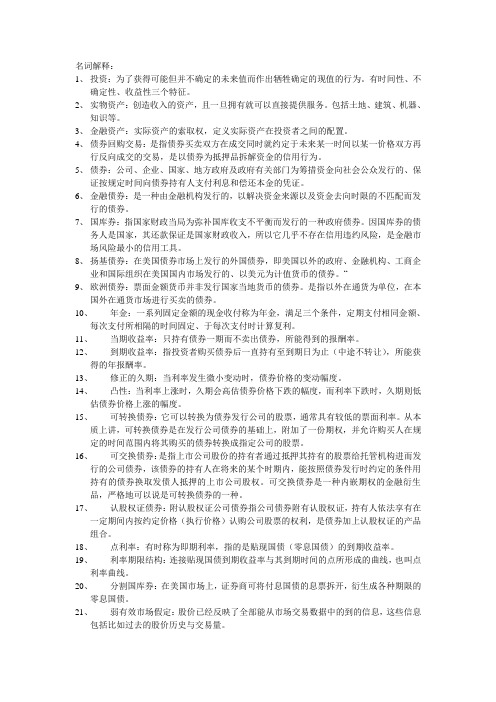
名词解释:1、投资:为了获得可能但并不确定的未来值而作出牺牲确定的现值的行为。
有时间性、不确定性、收益性三个特征。
2、实物资产:创造收入的资产,且一旦拥有就可以直接提供服务。
包括土地、建筑、机器、知识等。
3、金融资产:实际资产的索取权,定义实际资产在投资者之间的配置。
4、债券回购交易:是指债券买卖双方在成交同时就约定于未来某一时间以某一价格双方再行反向成交的交易,是以债券为抵押品拆解资金的信用行为。
5、债券:公司、企业、国家、地方政府及政府有关部门为筹措资金向社会公众发行的、保证按规定时间向债券持有人支付利息和偿还本金的凭证。
6、金融债券:是一种由金融机构发行的,以解决资金来源以及资金去向时限的不匹配而发行的债券。
7、国库券:指国家财政当局为弥补国库收支不平衡而发行的一种政府债券。
因国库券的债务人是国家,其还款保证是国家财政收入,所以它几乎不存在信用违约风险,是金融市场风险最小的信用工具。
8、扬基债券:在美国债券市场上发行的外国债券,即美国以外的政府、金融机构、工商企业和国际组织在美国国内市场发行的、以美元为计值货币的债券。
“9、欧洲债券:票面金额货币并非发行国家当地货币的债券。
是指以外在通货为单位,在本国外在通货市场进行买卖的债券。
10、年金:一系列固定金额的现金收付称为年金,满足三个条件,定期支付相同金额、每次支付所相隔的时间固定、于每次支付时计算复利。
11、当期收益率:只持有债券一期而不卖出债券,所能得到的报酬率。
12、到期收益率:指投资者购买债券后一直持有至到期日为止(中途不转让),所能获得的年报酬率。
13、修正的久期:当利率发生微小变动时,债券价格的变动幅度。
14、凸性:当利率上涨时,久期会高估债券价格下跌的幅度,而利率下跌时,久期则低估债券价格上涨的幅度。
15、可转换债券:它可以转换为债券发行公司的股票,通常具有较低的票面利率。
从本质上讲,可转换债券是在发行公司债券的基础上,附加了一份期权,并允许购买人在规定的时间范围内将其购买的债券转换成指定公司的股票。
固定收益证券试题及答案

固定收益证券试题及答案一、单项选择题(每题2分,共20分)1. 固定收益证券的主要风险不包括以下哪一项?A. 利率风险B. 信用风险C. 流动性风险D. 汇率风险答案:D2. 以下哪个不是固定收益证券的特点?A. 收益固定B. 投资期限长C. 风险较低D. 价格波动大答案:D3. 债券的票面利率与市场利率的关系是:A. 总是相等的B. 总是不等的C. 有时相等,有时不等D. 以上都不对答案:C4. 如果市场利率上升,而债券的票面利率保持不变,那么债券的:A. 价格上升B. 价格下降C. 价格不变D. 与市场利率无关答案:B5. 以下哪个不是固定收益证券的种类?A. 政府债券B. 企业债券C. 股票D. 金融债券答案:C6. 债券的到期收益率是指:A. 债券的票面利率B. 债券的当前市场价格C. 投资者持有到期的年化收益率D. 债券的发行价格答案:C7. 以下哪个因素不会影响固定收益证券的收益率?A. 发行主体的信用等级B. 债券的期限C. 市场利率水平D. 投资者的风险偏好答案:D8. 债券的久期是指:A. 债券的到期时间B. 债券的加权平均到期时间C. 债券的票面金额D. 债券的发行时间答案:B9. 以下哪个不是影响债券价格的因素?A. 债券的票面利率B. 债券的信用等级C. 债券的发行量D. 市场利率的变化答案:C10. 以下哪个是固定收益证券投资的主要目的?A. 资本增值B. 获得稳定的现金流C. 参与公司决策D. 投机取利答案:B二、多项选择题(每题3分,共15分)11. 固定收益证券的收益来源主要包括哪些?(ACD)A. 利息收入B. 股票升值C. 资本利得D. 再投资收益12. 以下哪些因素会影响固定收益证券的信用风险?(ABD)A. 发行主体的财务状况B. 经济环境的变化C. 投资者的个人偏好D. 法律和政策环境13. 固定收益证券的流动性通常与以下哪些因素有关?(ACD)A. 债券的发行量B. 债券的票面利率C. 市场交易的活跃度D. 债券的到期时间14. 以下哪些措施可以降低固定收益证券的投资风险?(ABD)A. 分散投资B. 选择信用等级较高的债券C. 增加投资金额D. 关注市场利率变动15. 固定收益证券的久期与以下哪些因素有关?(ABC)A. 债券的现金流时间B. 每笔现金流的金额C. 每笔现金流的现值D. 债券的票面利率三、判断题(每题1分,共10分)16. 固定收益证券的风险总是低于股票。
固定收益证券5套题

1、某8年期债券,第1~3年息票利率为6.5%,第4~5年为7%,第6~7年为7.5%,第8年升为8%,该债券就属于(A 多级步高债券)。
3、固定收益产品所面临的最大风险是(B 利率风险)。
5、目前我国最安全和最具流动性的投资品种是(B 国债)6、债券到期收益率计算的原理是(A 到期收益率是购买债券后一直持有到期的内含报酬率)。
7、在纯预期理论的条件下,下凸的的收益率曲线表示(B 短期利率在未来被认为可能下降)。
9、如果债券嵌入了可赎回期权,那么债券的利差将如何变化?(B 变小)11、5年期,10%的票面利率,半年支付。
债券的价格是1000元,每次付息是(B 50元)。
12、若收益率大于息票率,债券以(A 低于)面值交易;13、贴现率升高时,债券价值(A 降低)14、随着到期日的不断接近,债券价格会不断(C 接近)面值。
15、债券的期限越长,其利率风险(A 越大)。
16、投资人不能迅速或以合理价格出售公司债券,所面临的风险为(B 流动性风险)。
17、投资于国库券时可以不必考虑的风险是(A 违约风险)18、当市场利率大于债券票面利率时,一般应采用的发行方式为(B 折价发行)。
19、下列投资中,风险最小的是(B 购买企业债券)。
20、下面的风险衡量方法中,对可赎回债券风险的衡量最合适的是(B 有效久期)。
26、以下哪项资产不适合资产证券化?(D 股权)27、以下哪一种技术不属于内部信用增级?(C 担保)28、一位投资经理说:“对债券组合进行单期免疫,仅需要满足以下两个条件:资产的久期和债务的久期相等;资产的现值与负债的现值相等。
(B 不对,因为还必须考虑信用风险)固定收益市场上,有时也将(A.零息债券)称为深度折扣债券。
下列哪种情况,零波动利差为零?A.如果收益率曲线为平某人希望在5年末取得本利和20000元,则在年利率为2%,单利计息的方式下,此人现在应当存入银行(B.18181、82)元。
在投资人想出售有价证券获取现金时,证券不能立即出售的风险被称为(C.变现力风险)。
《固定收益证券》课程练习题
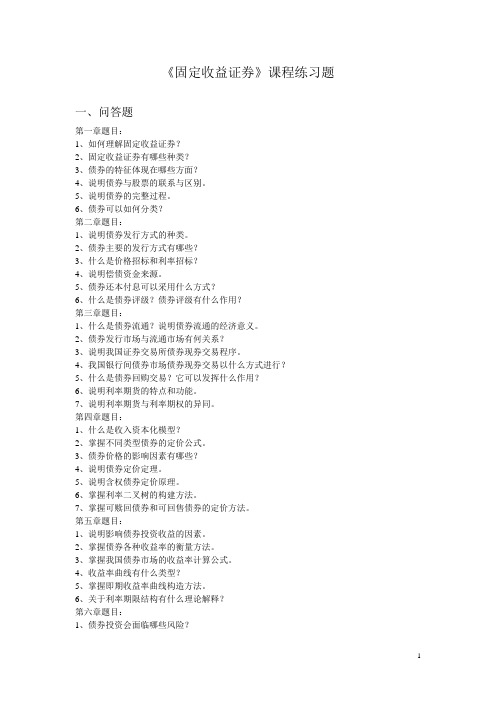
《固定收益证券》课程练习题一、问答题第一章题目:1、如何理解固定收益证券?2、固定收益证券有哪些种类?3、债券的特征体现在哪些方面?4、说明债券与股票的联系与区别。
5、说明债券的完整过程。
6、债券可以如何分类?第二章题目:1、说明债券发行方式的种类。
2、债券主要的发行方式有哪些?3、什么是价格招标和利率招标?4、说明偿债资金来源。
5、债券还本付息可以采用什么方式?6、什么是债券评级?债券评级有什么作用?第三章题目:1、什么是债券流通?说明债券流通的经济意义。
2、债券发行市场与流通市场有何关系?3、说明我国证券交易所债券现券交易程序。
4、我国银行间债券市场债券现券交易以什么方式进行?5、什么是债券回购交易?它可以发挥什么作用?6、说明利率期货的特点和功能。
7、说明利率期货与利率期权的异同。
第四章题目:1、什么是收入资本化模型?2、掌握不同类型债券的定价公式。
3、债券价格的影响因素有哪些?4、说明债券定价定理。
5、说明含权债券定价原理。
6、掌握利率二叉树的构建方法。
7、掌握可赎回债券和可回售债券的定价方法。
第五章题目:1、说明影响债券投资收益的因素。
2、掌握债券各种收益率的衡量方法。
3、掌握我国债券市场的收益率计算公式。
4、收益率曲线有什么类型?5、掌握即期收益率曲线构造方法。
6、关于利率期限结构有什么理论解释?第六章题目:1、债券投资会面临哪些风险?2、公司债券的信用风险如何分析?3、普通债券和含权债券的价格与收益率关系有何差异?4、说明债券价格的波动性特征。
5、掌握久期的计算办法。
6、说明久期的特性和局限性。
7、掌握凸度的计算公式。
第七章题目:1、债券投资在投资体系中处于什么地位?2、说明债券投资管理步骤。
3、债券投资有什么技巧?4、说明消极型债券投资策略的依据和方法。
5、掌握免疫组合的构造方法。
6、说明积极型债券投资策略的依据和方法。
7、试对消极型投资策略和积极型投资策略进行比较。
8、什么是或有免疫法?第八章题目:1、政府债券有什么特点?2、说明国债发行对资金市场的影响。
固定收益证券试题
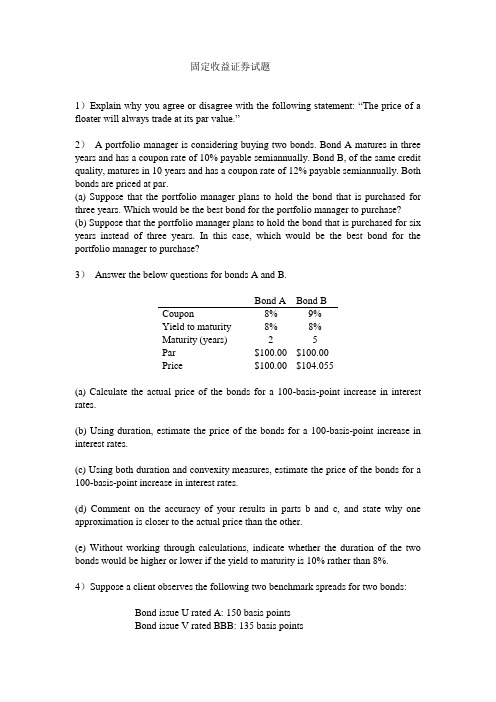
固定收益证券试题1)Explain why you agree or disagree with the following statement: “The price of a floater will always trade at its par value.”2)A portfolio manager is considering buying two bonds. Bond A matures in three years and has a coupon rate of 10% payable semiannually. Bond B, of the same credit quality, matures in 10 years and has a coupon rate of 12% payable semiannually. Both bonds are priced at par.(a) Suppose that the portfolio manager plans to hold the bond that is purchased for three years. Which would be the best bond for the portfolio manager to purchase? (b) Suppose that the portfolio manager plans to hold the bond that is purchased for six years instead of three years. In this case, which would be the best bond for the portfolio manager to purchase?3)Answer the below questions for bonds A and B.Bond A Bond BCoupon 8% 9%Yield to maturity 8% 8%Maturity (years) 2 5Par $100.00 $100.00Price $100.00 $104.055(a) Calculate the actual price of the bonds for a 100-basis-point increase in interest rates.(b) Using duration, estimate the price of the bonds for a 100-basis-point increase in interest rates.(c) Using both duration and convexity measures, estimate the price of the bonds for a 100-basis-point increase in interest rates.(d) Comment on the accuracy of your results in parts b and c, and state why one approximation is closer to the actual price than the other.(e) Without working through calculations, indicate whether the duration of the two bonds would be higher or lower if the yield to maturity is 10% rather than 8%.4)Suppose a client observes the following two benchmark spreads for two bonds: Bond issue U rated A: 150 basis pointsBond issue V rated BBB: 135 basis pointsYour client is confused because he thought the lower-rated bond (bond V) should offer a higher benchmark spread than the higher-rated bond (bond U). Explain why the benchmark spread may be lower for bond U.5)The bid and ask yields for a Treasury bill were quoted by a dealer as 5.91% and 5.89%, respectively. Shouldn’t the bid yield be less than the ask yield, because the bid yield indicates how much the dealer is willing to pay and the ask yield is what the dealer is willing to sell the Treasury bill for?6)What is the difference between a cash-out refinancing and a rate-and-term refinancing?7)Describe the cash flow of a mortgage pass-through security.8)Explain the effect on the average lives of sequential-pay structures of including an accrual tranche in a CMO structure.。
固定收益证券期末试题
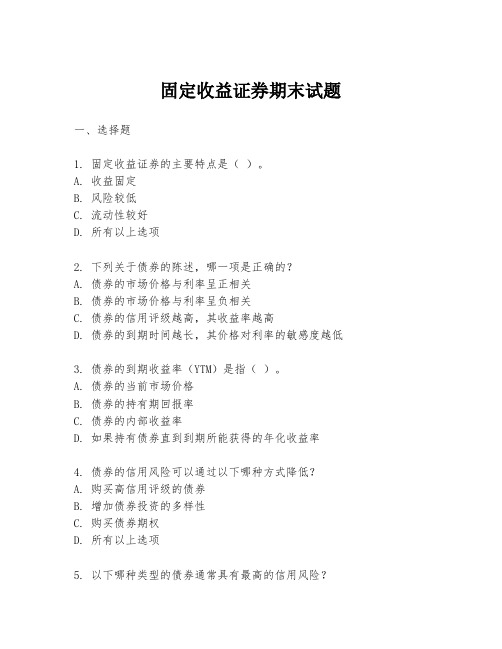
固定收益证券期末试题一、选择题1. 固定收益证券的主要特点是()。
A. 收益固定B. 风险较低C. 流动性较好D. 所有以上选项2. 下列关于债券的陈述,哪一项是正确的?A. 债券的市场价格与利率呈正相关B. 债券的市场价格与利率呈负相关C. 债券的信用评级越高,其收益率越高D. 债券的到期时间越长,其价格对利率的敏感度越低3. 债券的到期收益率(YTM)是指()。
A. 债券的当前市场价格B. 债券的持有期回报率C. 债券的内部收益率D. 如果持有债券直到到期所能获得的年化收益率4. 债券的信用风险可以通过以下哪种方式降低?A. 购买高信用评级的债券B. 增加债券投资的多样性C. 购买债券期权D. 所有以上选项5. 以下哪种类型的债券通常具有最高的信用风险?A. 国债B. 地方政府债券C. 公司债D. 可转换债券二、简答题1. 请简述固定收益证券的定义及其主要类型。
2. 描述债券的久期以及它如何帮助投资者管理利率风险。
3. 解释债券信用评级的基本原理,并举例说明不同信用评级对投资者的意义。
三、计算题1. 假设你购买了一张面值为1000元,年票面利率为5%,剩余期限为10年的债券,当前市场价格为950元。
请计算该债券的到期收益率(YTM)。
2. 假设你持有一张面值为1000元,票面利率为6%,剩余期限为5年的债券,你预计在2年后将其出售。
如果当前的即期利率为4%,请使用久期估算你持有的债券在2年后的大致市场价格。
四、论述题1. 论述固定收益证券在投资组合管理中的作用及其对投资组合风险和收益的影响。
2. 分析当前经济环境下,投资者应如何选择合适的固定收益证券策略来优化其投资组合。
3. 讨论利率变动对固定收益证券市场的影响,以及投资者可以采取哪些策略来应对这些变动。
请注意,以上内容仅为试题框架,具体答案需要根据实际情况和所学知识进行详细解答。
在撰写答案时,应确保分析准确、逻辑清晰,并结合实际案例或数据支持观点。
固定收益证券 复习题

《固定收益证券》一、单项选择题(每小题2分,本题共28分。
每小题只有一个选项符合题意,请选择正确答案。
)1.目前我国最安全和最具流动性的投资品种是( B )A.金融债B.国债C.企业债D.公司债2.债券的期限越长,其利率风险( A )。
A.越大B.越小C.与期限无关D.无法确定3.5年期,10%的票面利率,半年支付。
债券的价格是1000元,每次付息是( B )。
元元元元4.下列哪种情况,零波动利差为零?( A )A.如果收益率曲线为平B.对零息债券来说C.对正在流通的财政债券来说D.对任何债券来说5.在投资人想出售有价证券获取现金时,证券不能立即出售的风险被称为( C )。
A.违约风险B.购买力风险C.变现力风险D.再投资风险6.如果采用指数化策略,以下哪一项不是限制投资经理复制债券基准指数的能力的因素?( B )A.某种债券发行渠道的限制B.无法及时追踪基准指数数据C.成分指数中的某些债券缺乏流动性D.投资经理与指数提供商对债券价格的分歧7.如果采用指数化策略,以下哪一项不是限制投资经理复制债券基准指数的能力的因素?( B )A.某种债券发行渠道的限制B.无法及时追踪基准指数数据C.成分指数中的某些债券缺乏流动性D.投资经理与指数提供商对债券价格的分歧8.投资于国库券时可以不必考虑的风险是( A )A.违约风险B.利率风险C.购买力风险D.期限风险9.某人希望在5年末取得本利和20000元,则在年利率为2%,单利计息的方式下,此人现在应当存入银行( B )元。
10.固定收益市场上,有时也将( A )称为深度折扣债券。
A.零息债券B.步高债券C.递延债券D.浮动利率债券11.贴现率升高时,债券价值( A )A.降低B.升高C.不变D.与贴现率无关12.以下有三种债券投资组合,它们分别对一笔7年到期的负债免疫。
所有债券都是政府发行的无内置期权债券。
有人认为:“因为三种组合都对负债进行了免疫,所以它们有同样程度的再投资风险”。
固定收益证券试题及部分答案

固定收益证券试题及部分答案班级序号:学号:姓名:成绩:1)Explain why you agree or disagree with the following statement: “The price of a floater will always trade at its par value.”Answer:I disagree with the statement: “The price of a floater will always trade at its par value.”First, the coupon rate of a floating-rate security (or floater) is equal to a reference rate plus some spread or margin. For example, the coupon rate of a floater can reset at the rate on a three-month Treasury bill (the reference rate) plus 50 basis points (the spread). Next, the price of a floater depends on two factors: (1) the spread over the reference rate and (2) any restrictions that may be imposed on the resetting of the coupon rate. For example, a floater may have a maximum coupon rate called a cap or a minimum coupon rate called a floor. The price of a floater will trade close to its par value as long as (1) the spread above the reference rate that the market requires is unchanged and (2) neither the cap nor the floor is reached. However, if the market requires a larger (smaller) spread, the price of a floater will trade below (above) par. If the coupon rate is restricted from changing to the reference rate plus the spread because of the cap, then the price of a floater will trade below par.2)A portfolio manager is considering buying two bonds. Bond A matures in three years and has a coupon rate of 10% payable semiannually. Bond B, of the same credit quality, matures in 10 years and has a coupon rate of 12% payable semiannually. Both bonds are priced at par.(a) Suppose that the portfolio manager plans to hold the bond that is purchased for three years. Which would be the best bond for the portfolio manager to purchase?Answer:The shorter term bond will pay a lower coupon rate but it will likely cost less for a given market rate.Since the bonds are of equal risk in terms of creit quality (The maturity premium for the longer term bond should be greater),the question when comparing the two bond investments is:What investment will be expecte to give the highest cash flow per dollar invested?In other words,which investment will be expected to give the highest effective annual rate of return.In general,holding the longer term bond should compensate the investor in the form of a maturity premium and a higher expected return.However,as seen in the discussion below,the actual realized return for either investment is not known with certainty.To begin with,an investor who purchases a bond can expect to receive a dollar return from(i)the periodic coupon interest payments made be the issuer,(ii)ancapital gainwhen the bond matures,is called,or is sold;and (iii)interest income generated from reinvestment of the periodic cash flows.The last component of the potential dollar return is referred to as reinvestment income.For a standard bond(our situation)that makes only coupon payments and no periodic principal payments prior to the maturity date,the interim cash flows are simply the coupon payments.Consequently,for such bonds the reinvestment income is simply interest earned from reinvesting the coupon interest payments.For these bonds,the third component of the potential source of dollar return is referred to as the interest-on-interest components.If we are going to coupute a potential yield to make a decision,we should be aware of the fact that any measure of a bond’s potential yield should take into consideration each of the three components described above.The current yield considers only the coupon interest payments.No consideration is given to any capital gain or interest on interest.The yield to maturity takes into account coupon interest and any capitalgain.It also considers the interest-on-interest component.Additionally,implicit in the yield-to-maturity computation is the assumption that the coupon payments can be reinvested at the computed yield to maturity.The yield to maturity is a promised yield and will be realized only if the bond is held to maturity and the coupon interest payments are reinvested at the yield to maturity.If the bond is not held to maturity and the couponpayments are reinvested at the yield to maturity,then the actual yield realized by an investor can be greater than or less than the yield to maturity.Given the facts that(i)one bond,if bought,will not be held to maturity,and(ii)the coupon interest payments will be reinvested at an unknown rate,we cannot determine which bond might give the highest actual realized rate.Thus,we cannot compare them based upon this criterion.However,if the portfolio manager is risk inverse in sense that she or he doesn’t want to buy a longer term bond,which will likel have more variability in its return,then the manager might prefer the shorter term bond(bondA) of thres years.This bond also matures when the manager wants to cash in the bond.Thus,the manager would not have to worry about any potential capital loss in selling the longer term bond(bondB).The manager would know with certainty what the cash flows are.IfThese cash flows are spent when received,the manager would know exactly how much money could be spent at certain points in time.Finally,a manager can try to project the total return performance of a bond on the basis of the panned investment horizon and expectations concerning reinvestment rates and future market yields.This ermits the portfolio manager to evaluate thich of several potential bonds considered for acquisition will perform best over the planned investment horizon.As we just rgued,this cannot be done using the yield to maturity as a measure of relative .coming total returnto assess performance over some investment horizon is called horizon analysis.When a total return is calculated oven an investment horizon,it is referred to as a horizon return.The horizon analysis framwor enabled the portfolio manager to analyze the performance of a bond under different interest-rate scenarios for reinvestment rates and future market yields.Only by investigating multiple scenarios can the portfolio manager see how sensitive the bond’s performance will be to each scenario.This can help the manager choosebetween the two bond choices.(b) Suppose that the portfolio manager plans to hold the bond that is purchased for six years instead of three years. In this case, which would be the best bond for the portfolio manager to purchase?Answer:Similear to our discussion in part(a),we do not know which investment would give the highest actual relized return in six years when we consider reinvesting all cash flows.If the manager buys a three-year bond,then there would be the additional uncertainty of now knowing what three-year bond rates would be in three years.The purchase of the ten-year bond would be held longer than previously(six years compared to three years)and render coupon payments for a six-year period that are known.If these cash flows are spent when received,the manager will know exactly how much money could be spent at certain points in timeNot knowing which bond investment would give thehighest realized return,the portfolio manager would choose the bond that fits the firm’s goals in terms of maturity.3)Answer the below questions for bonds A and B.Bond A Bond BCoupon 8% 9%rYield to maturity 8% 8%Maturity (years) 2 5Par $100.00 $100.00Price $100.00 $104.055(a) Calculate the actual price of the bonds for a 100-basis-point increase ininterest rates.Answer:For Bond A, we get a bond quote of $100 for our initial price if we have an 8% coupon rate and an 8% yield. If we change the yield 100 basis point so the yield is 9%, then the value of the bond (P) is the present value of the coupon payments plus the present value of the par value. We have C = $40, y = 4.5%, n = 4, and M = $1,000. Inserting these numbers into our present value of coupon bond formula, we get:41111(1)(10.045)$40$143.5010.045nr P C r ????--???? ===????????????????The present value of the par or maturity value of $1,000 is:4$1,000$838.561(1)(1.045)n M r == Thus, the value of bond A with a yield of 9%, a coupon rate of 8%, and a maturity of 2 years is: P = $143.501 $838.561 = $982.062. Thus, we get a bond quote of $98.2062. We already know that bond B will give a bond value of $1,000 and a bond quote of $100 since a change of 100 basis points will make the yield and couponrate the same, For example, inserting Thus, the value of bond A with a yield of 9%, a coupon rate of 8%, and a maturity of 2 years is: P = $143.501 $838.561 = $982.062. Thus, we get a bond quote of $98.2062. We already know that bond B will give a bond value of $1,000 and a bond quote of $100 since a change of 100 basis points will make the yield and coupon rate the same, For example, inserting(b) Using duration, estimate the price of the bonds for a 100-basis-point increase in interest rates.Answer:To estimate the price of bond A, we begin by first computing the modified duration. We can use an alternative formula that does not require the extensive calculations required by the Macaulay procedure. The formula is:211(100/)1(1)(1)n n Cn C y y y y Modified Duration P ??-- ?? ??=Putting all applicable variables in terms of $100, we have C = $4, n = 4, y = 0.045, and P = $98.2062. Inserting these values, in the modified duration formula gives: 212451(100/)$414($100$4/0.045)11(1)(1)0.045(1.045)(1.045)98.2062n n C n C y y y y Modified Duration P ????--- - ???? ????===($1,975.308642[0.161439] $35.664491) / $98.2062 = ($318.89117 $35.664491) / $98.2062 = $354.555664 / $98.2062 = 3.6103185 or about 3.61. Converting to annual number by dividing by two gives a modified duration of 1.805159 (before the increase in 100 basis points it was 1.814948). We next solve for the change in price using the modified duration of 1.805159 and dy = 100 basis points = 0.01. We have: ()() 1.805159(0.01)0.0180515dP Modified Duration dy P=-=-=- We can now solve for the new price of bond A as shown below:(1)(10.0180515)$1,000$981.948dP P P=-= This is slightly less than the actual price of $982.062. The difference is $982.062 –$981.948 = $0.114. To estimate the price of bond B, we follow the same procedure just shown for bond A. Using the alternative formula for modified duration that does not require the extensive calculations required by the Macaulay procedure and noting that C = $45, n = 10, y = 0.045, and P = $100, we get:21210111(100/)$4.5110($100$4.5/0.045)11(1)(1)0.045(1.045)(1.045)$100n n C n C y y y y Modified Duration P ????--- - ???? ????== ($791.27182 $0) / $100 = 7.912718 or about 7.91 (before the increase in 100 basis points it was7.988834 or about 7.99). Converting to an annual number by dividing by two gives a modified duration of 3.956359 (before the increase in 100 basis points it was 3.994417). We will now estimate the price of bond B using the modified durationmeasure. With 100 basis points giving dy = 0.01 and an approximate duration of 3.956359, we have:()() 3.956359(0.01)0.0395635dP Modified Duration dy P=-=-=-Thus, the new price is(1 –0.0395635)$1,040.55 = (0.9604364)$1,040.55 = $999.382.This is slightly less than the actual price of $1,000. The difference is $1,000 –$999.382 = $0.618.(c) Using both duration and convexity measures, estimate the price of the bonds for a 100-basis-point increase in interest rates. Answer:For bond A, we use the duration and convexity measures as given below. First, we use the duration measure. We add 100 basis points and get a yield of 9%. We now have C = $40, y = 4.5%, n = 4, and M = $1,000. NOTE. In part (a) we computed the actual bondprice and got P = $982.062. Prior to that, the price sold at par (P = $1,000) since the coupon rate and yield were then equal. The actual change in price is: ($982.062 –$1,000) = $17.938 and the actual percentage change in price is: $17.938 / $1,000 = 0.017938%. We will now estimate the price by first approximating the dollar price change. With 100 basis points giving dy = 0.01 and a modified duration computed in part (b) of 1.805159, we have:()() 1.805159(0.01)0.01805159dP Modified Duration dy P=-=-=- This is slightly more negative than the actual percentage decrease in price of1.7938%. The difference is 1.7938% –( 1.805159%) = 1.7938% 1.805159% = 0.011359%. Using the 1.805159% just given by the duration measure, the new price for bond A is:(1)(10.01805159)$1,000$981.948dP P P=-= This is slightly less than the actual price of $982.062. The difference is $982.062 –$981.948 = $0.114. Next, we use the convexity measure to see if we can account for the difference of 0.011359%. We have: convexity measure(half years) =2232121212(1)(100/)11(1)(1)(1)n n n d P C Cn n n C y dy P y y y y y P ???? -??=-- ?????? ?????? For bond A, we add 100 basis points and get a yield of 9%. We now have C = $40, y = 4.5%, n = 4, and M = $1,000. NOTE. In part (a) we computed the actual bond price and got P = $982.062. Prior to that, the price sold at par (P = $1,000) since the coupon rate and yield were then equal. Expressing numbers in terms of a $100 bond quote, we have: C = $4, y = 0.045, n = 4, and P = $98.2062. Inserting these numbers into our convexity measure formula gives:convexity measure (half years) = 342562$412($4)44(5)(100$4/0.045)1116.93250.045(1.045)0.045(1.045)(1.045)$ 98.2062y ????-=??-- =???????????? 2216.9325() 4.2331252Convexity Measure inm period per year TheConvexity Measure in years m === Adding the duration measure and the convexity measure, we get 1.805159% 0.021166% = 1.783994%. Recall the actual change in price is: ($982.062 –$1,000) = $17.938 and the actual percentage change in price is: $17.938 / $1,000 = ?0.017938 or approximately 1.7938%. Using the 1.783994% resulting from both the duration and convexity measures, we can estimate the new price for bond A. We have:Pr (1)(10.01783994)$1,000(0.9819484)$1,000$982.160dP New ice P P= = -== Adding the duration measure and the convexity measure, we get 1.805159% 0.021166% = 1.783994%. Recall the actual change in price is: ($982.062 –$1,000) = $17.938 and the actual percentage change in price is: $17.938 / $1,000 = ?0.017938 or approximately 1.7938%. Using the 1.783994% resulting from both the duration and convexity measures, we can estimate the new price for bond A. We have:()() 3.056359(0.01)0.0395635dP Modified Duration dy P=-=-=- This is slightly more negative than the actual percentage decrease in price of -3.896978%. The difference is (-3.896978%)-(-3.95635%)=0.059382%Using the -3.95635%just given by the duration measure, the new price for Bond B is: (1)(10.0395635)$1,040.55$999.382dP P P=-=This is slightly less than the actual price of $1,000. This difference is $1,000-$999.382=$0.618We use the convexity measure to see if we can account for the difference of 00594%. We have:2232121212(1)(100/)1()1(1)(1)(1)n n n d P C Cn n n C y Convexity Measure half years dy P y y y y y P ???? -??==-- ?????? ?????? For Bond B, 100 basis points are added and get a yield of 9%. We now have C=$45, y=4.5%, n=10, and M=$1,000. Note in part (a), we computed the actual bond price and got P=$1,000 since the coupon rate and yield were then equal. Prior to that, the price sold at P=$1,040.55. Expressing numbers in terms of a $100 bond quote, we have C=$4.5, y-0.045, n=10 and P=$100. Inserting these numbers into our convexity measure formula gives:310211122($4.5)12($4.5)410(11)(100$4.5/0.045)1()1(0.045)(1.045)(0.045)(1.04 5)(1.045)$100Convexity Measure half years ????-??=-- ???????????? 7,781.03[0.01000]77.8103==The convexity measure (in years)=2277.810319.4525642convexitymeasureinm period per year m == Note. DollarConvexity Measure=Convexity Measure (years) times P=19.452564($100)=$1,945.2564.The percentage price change due to convexity is 21()2dP convexity measure dy P = Inserting in the values, we get 21(77.8103)(0.01)0.000974632dP P == Thus, we have 0.097463% increase in price when we adjust for convexity measure.Adding the duration measure and convexity measure, we get -3.9563659% 0.097263% equals -3.859096%. Recall the actual change in price is ($1,000-$1,040.55)=-$40.55 and the actual new price is(1)(10.03859096)$1,040.55(0.9614091)$1,040.55$1,000.394dP P P-=-== For Bond A. This is about the same as the actual price of $1,000. The difference is $1,000.394-$1,000=$0.394. Thus, using the convexity measure along with the duration measure has narrowed the estimated price from a difference of -$0.618 to $0.394.(d) Comment on the accuracy of your results in parts b and c, and state why one approximation is closer to the actual price than the other.Answer:For bond A, the actual price is $982.062. When we use the duration measure, we get a bond price of $981.948 that is $0.114 less than the actual price. When we use duration and convex measures together, we get a bond price of $982.160. This is slightly more than the actual price of $982.062. The difference is $982.160 –$982.062 = $0.098. Thus, using the convexity measure along with the duration measure has narrowed the estimated price from a difference of $0.114 to $0.0981. For bond B, the actual price is $1,000. When we use the duration measure, we get a bond price of $999.382 that is $0.618 less than the actual price. When we use duration and convex measures together, we get a bond price of $1,000.394. This is slightly more than the actual price of $1,000. The difference is $1,000.394 –$1,000 = $0.394. Thus, using the convexity measure along with the duration measure has narrowed the estimated price from a difference of ?$0.618 to $0.394As we see, using the duration and convexity measures together is more accurate. The reason is that adding the convexity measure to our estimate enables us to include the second derivative that corrects for the convexity of the price-yield relationship. Moredetails are offered below. Duration (modified or dollar) attempts to estimatea convex relationship with a straight line (the tangent line). We can specify a mathematical relationship that provides a better approximation to the price change of the bond if the required yield changes. We do this by using the first two terms of a Taylor series to approximate the price change as follows:2221()(1)2dP d P dP dy dy error dy dy = Dividing both sides of this equation by P to get the percentage price change gives us: 22211()(2)2dP dP d P error dy dy P dy P dy P =The first term on the right-hand side of equation (1) is equation for the dollar price change based on dollar duration and is our approximation of the price change based on duration. In equation (2), the first term on the right-hand side is the approximate percentage change in price based on modified duration. The second term in equations(1) and (2) includes the second derivative of the price function for computing the value of a bond. It is the second derivative that is used as a proxy measure to correct for the convexity of the price-yield relationship. Market participants refer to the second derivative of bond price function as the dollar convexity measure of the bond. The second derivative divided by price is a measure of the percentage change in the price of the bond due to convexity and is referred tosimply as the convexity measure.(e) Without working through calculations, indicate whether the duration of the two bonds would be higher or lower if the yield to maturity is 10% rather than 8%.Answer: Like term to maturity and coupon rate, the yield to maturity is a factor that influences price volatility. Ceteris paribus, the higher the yield level, the lower the price volatility. The same property holds for modified duration. Thus, a 10% yield to maturity will have both less volatility than an 8% yield to maturity and also a smaller duration. There is consistency between the properties of bond price volatility and the properties of modified duration. When all other factors are constant, a bond with a longer maturity will have greater price volatility. A property of modified duration is that when all other factors are constant, a bond with a longer maturity will have a greater modified duration. Also, all other factors being constant, a bond with a lower coupon rate will have greater bond price volatility. Also, generally, a bond with a lower coupon rate will have a greater modified duration. Thus, bonds with greater durations will greater price volatilities.4)Suppose a client observes the following two benchmark spreads for two bonds:Bond issue U rated A: 150 basis pointsBond issue V rated BBB: 135 basis pointsYour client is confused because he thought the lower-rated bond (bond V) should offer a higher benchmark spread than the higher-rated bond (bond U). Explain why the benchmark spread may be lower for bond U.5)The bid and ask yields for a Treasury bill were quoted by a dealer as 5.91% and 5.89%, respectively. Shouldn’t the bid yield be less than the ask yield, because the bid yield indicates how much the dealer is willing to pay and the ask yield is what the dealer is willing to sell the Treasury bill for?Answer:The higher bid means a lower price. So the dealer is willing to pay less than would be paid for the lower ask price. We illustrate this below. Given the yield on a bank discount basis (Yd), the price of a Treasury bill is found by first solving the formula for the dollar discount (D), as follows:()()360d t D Y F = The price is then Price = F-DFor the 100-day Treasury bill with a face value (F) of $100,000, if the yield on a bank discount basis (Yd) is quoted as 5.91%, D is equal to:100()()0.0591($100,000)()$1,641.67360360d t D Y F ===Therefore, price = $100,000 –$1,641.67 = $98,358.33. For the 100-day Treasury bill with a face value (F) of $100,000, if the yield on a bank discount basis (Yd) is quoted as 5.89%, D is equal to:100()()0.0589($100,000)()$1,636.11360360d t D Y F === Therefore, price is: P = F –D = $100,000 –$1,636.11 = $98,363.89.Thus, the higher bid quote of 5.91% (compared to lower ask quote 5.89%) gives a lower selling price of $98,358.33 (compared to $98,363.89). The 0.02% higher yield translates into a selling price that is $5.56 lower. In general, the quoted yield on a bank discount basis is not a meaningful measure of the return from holding a Treasury bill, for two reasons. First, the measure is based on a face-value investment rather than on the actual dollar amount invested. Second, the yield is annualized according to a 360-day rather than a 365-day year, making it difficult to compare Treasury bill yields with Treasury notes and bonds, which pay interest on a 365-day basis. The use of 360 days for a year is a money market convention for some money market instruments, however. Despite its shortcomings as a measure of return, this is the method that dealers have adopted to quote Treasury bills. Many dealer quote sheets, and some reporting services, provide two other yield measures that attempt tomake the quoted yield comparable to that for a coupon bond and other money market instruments.6)What is the difference between a cash-out refinancing and a rate-and-term refinancing?Answer:When a lender is evaluating an application from a borrower who is refinancing, the loan-to-value ratio (LTV) is dependent upon the requested amount of the new loan and the market value of the property as determined byan appraisal. When the loan amount requested exceeds the original loan amount, the transaction is referred to as a cash-out-refinancing. If instead, there is financing where the loan balance remains unchanged, the transaction is said to be a rate-and-term refinancing or no-cash refinancing. That is, the purpose of refinancing the loan is to either obtain a better note rate or change the term of the loan.7)Describe the cash flow of a mortgage pass-through security.Answer:The cash flow of a mortgage pass-through security depends on the cash flow of the underlying mortgage.The cash flow consists of monthly mortgage payments representing interest,the scheduled repayment of principal,and any prepayments. Payments are made to security holders each month.Neither theamount nor the timing,however,of the cash flow from the pool of mortgages is identical to that of the cash flow passed through to investors.The monthly cash flow for a pass-through is less than the monthly cash flow of the underlying mortgages by an amount equal to servicing and other fees.The other fees are those charged by the issuer or guarantor of the pass-through for guaranteeing the issue.The coupon rage on a pass-through,called the pass-through coupon rate,is less than the mortgage rage on the underlying pool of mortgage loans by an amount equal to the servicing and guaranteeing feesThe timing of the cash flow,like the amount of the cash flow,is also different.The monthly mortgage payment is due from each mortgagor on the first day of each month,but there is a delay in passing through the corresponding monthly cash flow to the securityholders.The length of the delay varies by the type of pass-through security. Because of prepayments,the cash flow of a pass-through is also not known with certainty.8)Explain the effect on the average lives of sequential-pay structures of including an accrual tranche in a CMO structure.。
固定收益证券

固定收益证券集团文件发布号:(9816-UATWW-MWUB-WUNN-INNUL-DQQTY-《固定收益证券》期末复习题一、单项选择题(每小题2分,本题共28分。
每小题只有一个选项符合题意,请选择正确答案。
)1.目前我国最安全和最具流动性的投资品种是( B.国债)2.债券的期限越长,其利率风险(A.越大)。
3.5年期,10%的票面利率,半年支付。
债券的价格是1000元,每次付息是(B.50)。
4.下列哪种情况,零波动利差为零?(A.如果收益率曲线为平)5.在投资人想出售有价证券获取现金时,证券不能立即出售的风险被称为(C.变现力风)。
6.如果采用指数化策略,以下哪一项不是限制投资经理复制债券基准指数的能力的因素?(B.无法及时追踪基准指数数据)7.如果采用指数化策略,以下哪一项不是限制投资经理复制债券基准指数的能力的因素?(B.无法及时追踪基准指数数据)8.投资于国库券时可以不必考虑的风险是(A.违约风险)9.某人希望在5年末取得本利和20000元,则在年利率为2%,单利计息的方式下,此人现在应当存入银行()元。
10.固定收益市场上,有时也将(A.零息债券)称为深度折扣债券。
11.贴现率升高时,债券价值(A.降低)12.以下有三种债券投资组合,它们分别对一笔7年到期的负债免疫。
所有债券都是政府发行的无内置期权债券。
有人认为:“因为三种组合都对负债进行了免疫,所以它们有同样程度的再投资风险”。
他的看法正确吗?(D.不对,C组合比B组合的再投资风险大)13.5年期,10%的票面利率,半年支付。
债券的价格是1000元,每次付息是(B.50元)。
14.若收益率大于息票率,债券以(A.低于)面值交易;15.贴现率升高时,债券价值( A.降低)16.在投资人想出售有价证券获取现金时,证券不能立即出售的风险被称为(C.变现力风险)。
17.以下哪一种技术不属于内部信用增级?(C.担保)18.某8年期债券,第1~3年息票利率为6.5%,第4~5年为7%,第6~7年为7.5%,第8年升为8%,该债券就属于(A.多级步高债券)。
固定收益证券-简答题集

1.分别依据到期期限和发行价对国债进行分类。
答:依据到期期限对国债的分类:短期(bill):期限≤1 年中期(note): 1 年<期限≤10 年长期(bond)期限>10 年发行价:折价交易(面值>发行价)平价交易(面值=发行价)溢价交易(面值<发行价)2.简述债务市场的组织形式直接搜寻(direct search)无中介机构,交易频率低,成本高经纪人市场(brokered market)有中介机构,交易量大,搜寻成本具有规模经济性交易商市场( dealer market)投资者通过交易商买卖财政证券交易商可拥有多余的头寸拍卖市场(auction markets)所有市场参与者集中喊价,在保证市场不被操纵3.简述回购协议的内涵以及合约的基本要素。
回购交易可看做有担保的贷款回购交易中的证券被称为抵押品(collaterals)回购交易中的要素:到期期限( 隔夜、一周、其他)借入的现金额双方约定的利率4.简述异价拍卖的过程竞价者提交多个竞价(包括价格和需求数量) 。
财政部根据价格和所有竞价者在每个价位上的需求数量确定总需求曲线。
选择最高的竞价,并以最高的竞价分配证券。
剩下的供给将以次高的价格出售给相应的竞价者。
依此类推,直到供给全部用完。
5.简述一价拍卖的过程竞价者提交多个竞价(包括价格和需求数量) 。
财政部将汇总每个价格所对应的需求量,以此来确定市场的总需求曲线。
然后,财政部选择一个竞价,使得此时供给等于总需求。
在这个价格上,所有获胜的竞价者的需求都得到了满足。
最具有竞争性的竞价获得了分配证券的头号优先权。
6.简述一价拍卖(收益率)的过程竞价者提交竞价(包括收益率和需求数量) 。
财政部从最低收益率开始拍卖,然后一直上升到最高收益率。
此收益率是使得总需求恰好是为竞争者提供的总供给。
市场出清的收益率称为拍卖停止收益率。
报价低于拍卖停止收益率的竞价者赢得证券。
赢得证券的竞价者都以拍卖停止收益率获得证券。
固定收益证券试题及部分答案

固定收益证券试题及部分答案国际经济贸易学院研究生课程班《固定收益证券》试题班级序号:学号:姓名:成绩:1)Explain why you agree or disagree with the following statement: “The price of a floater will always trade at its par value.”Answer:I disagree with the statement: “The price of a floater will always trade at its par value.” First, the coupon rate of a floating-rate security (or floater) is equal to a reference rate plus some spread or margin. For example, the coupon rate of a floater can reset at the rate on a three-month Treasury bill (the reference rate) plus 50 basis points (the spread). Next, the price of a floater depends on two factors: (1) the spread over the reference rate and (2) any restrictions that may be imposed on the resetting of the coupon rate. For example, a floater may have a maximum coupon rate called a cap or a minimum coupon rate called a floor. The price of a floater will trade close to its par value as long as (1) the spread above the reference rate that the market requires is unchanged and (2) neither the cap nor the floor is reached. However, if the market requires a larger (smaller) spread, the price of a floater will trade below (above) par. If the coupon rate is restricted from changing to the reference rate plus the spread because of the cap, then the price of a floater will trade below par.2)A portfolio manager is considering buying two bonds. Bond A matures in three years and has a coupon rate of 10% payable semiannually. Bond B, of the same credit quality, matures in 10 years and has a coupon rate of 12% payable semiannually.Both bonds are priced at par.(a) Suppose that the portfolio manager plans to hold the bond that is purchased for three years. Which would be the best bond for the portfolio manager to purchase?Answer:The shorter term bond will pay a lower coupon rate but it will likely cost less for a given market rate.Since the bonds are of equal risk in terms of creit quality (The maturity premium for the longer term bond should be greater),the question when comparing the two bond investments is:What investment will be expecte to give the highest cash flow per dollar invested?In other words,which investment will be expected to give the highest effective annual rate of return.In general,holding the longer term bond should compensate the investor in the form of a maturity premium and a higher expected return.However,as seen in the discussion below,the actual realized return for either investment is not known with certainty.To begin with,an investor who purchases a bond can expect to receive a dollar return from(i)the periodic coupon interest payments made be the issuer,(ii)an capital gainwhen the bond matures,is called,or is sold;and (iii)interest income generated from reinvestment of the periodic cash flows.The last component of the potential dollar return is referred to as reinvestment income.For a standard bond(our situation)that makes only coupon payments and no periodic principal payments prior to the maturity date,the interim cash flows are simply the coupon payments.Consequently,for such bonds the reinvestment income is simply interest earned from reinvesting the coupon interest payments.For these bonds,the third component of the potential source of dollar return is referred to as the interest-on-interest components.If we are going to coupute a potential yield to make a decision,we should be aware of the fact that any measure of a bond’s potential yield should take into consideration each of the three components described above.The current yield considers only the coupon interest payments.No consideration is given to any capital gain or interest on interest.The yield to maturity takes into account coupon interest and any capital gain.It also considers the interest-on-interest component.Additionally,implicit in the yield-to-maturity computation is the assumption that the coupon payments can be reinvested at the computed yield to maturity.The yield to maturity is a promised yield and will be realized only if the bond is held to maturity and the coupon interest payments are reinvested at the yield to maturity.If the bond is not held to maturity and the coupon payments are reinvested at the yield to maturity,then the actual yield realized by an investor can be greater than or less than the yield to maturity.Given the facts that(i)one bond,if bought,will not be held to maturity,and(ii)the coupon interest payments will be reinvested at an unknown rate,we cannot determine which bond might give the highest actual realized rate.Thus,we cannot compare them based upon this criterion.However,if the portfolio manager is risk inverse in the sense that she or he doesn’t want to buy a longer term bond,which will likel have more variability in its return,then the manager might prefer the shorter term bond(bondA) of thres years.This bond also matures when the manager wants to cash in the bond.Thus,the manager would not have to worry about any potential capital loss in selling the longer term bond(bondB).The manager would know with certainty what the cash flows are.If These cash flows are spent when received,the managerwould know exactly how much money could be spent at certain points in time.Finally,a manager can try to project the total return performance of a bond on the basis of the panned investment horizon and expectations concerning reinvestment rates and future market yields.This ermits the portfolio manager to evaluate thich of several potential bonds considered for acquisition will perform best over the planned investment horizon.As we just rgued,this cannot be done using the yield to maturity as a measure of relative /doc/6814708511.html,ing total return to assess performance over some investment horizon is called horizon analysis.When a total return is calculated oven an investment horizon,it is referred to as a horizon return.The horizon analysis framwor enabled the portfolio manager to analyze the performance of a bond under different interest-rate scenarios for reinvestment rates and future market yields.Only by investigating multiple scenarios can the portfolio manager see how sensitive the bond’s performance will be to each scenario.This can help the manager choosebetween the two bond choices.(b) Suppose that the portfolio manager plans to hold the bond that is purchased for six years instead of three years. In this case, which would be the best bond for the portfolio manager to purchase?Answer:Similear to our discussion in part(a),we do not know which investment would give the highest actual relized return in six years when we consider reinvesting all cash flows.If the manager buys a three-year bond,then there would be the additional uncertainty of now knowing what three-year bondrates would be in three years.The purchase of the ten-year bond would be held longer than previously(six years compared to three years)and render coupon payments for a six-year period that are known.If these cash flows are spent when received,the manager will know exactly how much money could be spent at certain points in timeNot knowing which bond investment would give the highest realized return,the portfolio manager would choose the bond that fits the firm’s goals in terms of maturity.3) Answer the below questions for bonds A and B.Bond A Bond BCoupon 8% 9%Yield to maturity 8% 8%Maturity (years) 2 5Par $100.00 $100.00Price $100.00 $104.055(a) Calculate the actual price of the bonds for a 100-basis-point increase in interest rates.Answer:For Bond A, we get a bond quote of $100 for our initial price if we have an 8% coupon rate and an 8% yield. If we change the yield 100 basis point so the yield is 9%, then the value of the bond (P) is the present value of the coupon payments plus the present value of the par value. We have C = $40, y = 4.5%, n = 4, and M = $1,000. Inserting these numbers into our present value of coupon bond formula, we get:41111(1)(10.045)$40$143.5010.045nr P C r --++===The present value of the par or maturity value of $1,000 is: 4$1,000$838.561(1)(1.045)n M r ==+ Thus, the value of bond A with a yield of 9%, a coupon rate of 8%, and a maturity of 2years is: P = $143.501 + $838.561 = $982.062. Thus, we get a bond quote of $98.2062. We already know that bond B will give a bond value of $1,000 and a bond quote of $100 since a change of 100 basis points will make the yield and coupon。
《固定收益证券》综合测试题六
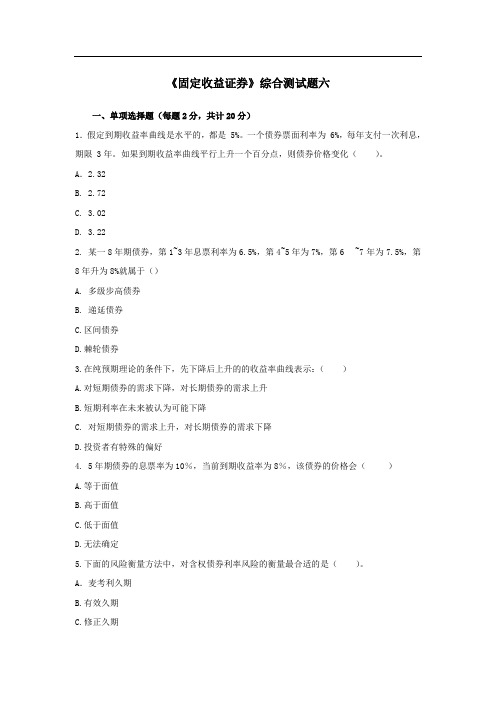
《固定收益证券》综合测试题六一、单项选择题(每题2分,共计20分)1.假定到期收益率曲线是水平的,都是 5%。
一个债券票面利率为 6%,每年支付一次利息,期限 3年。
如果到期收益率曲线平行上升一个百分点,则债券价格变化()。
A.2.32B. 2.72C. 3.02D. 3.222. 某一8年期债券,第1~3年息票利率为6.5%,第4~5年为7%,第6 ~7年为7.5%,第8年升为8%就属于()A. 多级步高债券B. 递延债券C.区间债券D.棘轮债券3.在纯预期理论的条件下,先下降后上升的的收益率曲线表示:()A.对短期债券的需求下降,对长期债券的需求上升B.短期利率在未来被认为可能下降C. 对短期债券的需求上升,对长期债券的需求下降D.投资者有特殊的偏好4. 5年期债券的息票率为10%,当前到期收益率为8%,该债券的价格会()A.等于面值B.高于面值C.低于面值D.无法确定5.下面的风险衡量方法中,对含权债券利率风险的衡量最合适的是()。
A.麦考利久期B.有效久期C.修正久期D.凸度6. 债券组合管理采用的指数策略非常困难是()A.主要指数中包含的债券种类太多,很难按适当比例购买B.许多债券交易量很小,所以很难以一个公平的市场价格买到C.投资经理需要大量的管理工作A、B和C7. 债券的期限越长,其利率风险()。
A.越大B.越小C.与期限无关D.无法确定8. 一个投资者按 85 元的价格购买了面值为 100元的两年期零息债券。
投资者预计这两年的通货膨胀率将分别为 4%和 5%。
则该投资者购买这张债券的真实到期收益率为()。
A.3.8B.5.1C.2.5D.4.29. On-the-run债券与off-the-run债券存在不同,On-the-run债券()A.比off-the-run债券期限更短B.比off-the-run债券期限更长C.为公开交易,off-the-run债券则不然D. 是同类债券中最新发行的10. 一位投资经理说:“对债券组合进行单期免疫,仅需要满足以下两个条件:资产的久期和债务的久期相等;资产的现值与负债的现值相等。
固定收益证券的复习计算题

F i x e d-i n c o m e t r e a s u r y Ppt31、公式:PracticeQuestion3.1Supposecurrently,1-yearspotrateis1%andmarketexpectsthat1-yearspotratenextyearwou ldbe2%and1-yearspotratein2yearswouldbe3%.Computetoday’s2-yearspotrate and3-yearspotrate.(已做答案)2、CurrentYieldComputethecurrentyieldfora7%8-yearbondwhosepriceis$94.17.Howaboutthecurrentyiel difpriceis$100,$106,respectively?3、?Case3.1Considera7%8-yearbondpayingcouponsemiannuallywhichissoldfor$94.17.Thepr esentvalueusingvariousdiscountrateis:A.WhatistheYTMforthisbond?B.Howmuchisthetotaldollarreturnonthisbond?C.Howmuchisthetotaldollarreturnifyouputthesameamountofdollarsintoadepositaccoun twiththesameannualyield?4、ForwardRates注:6-monthbillspotrateis3%是年化利率(3%要除以2)1-yearbillspotrateis3.3%是年化利率(3.3%要除以2)Ppt41、Fixed‐CouponBonds?PracticeQuestion4.2A.Whatisthevalueofa4-year10%couponbondthatpaysinterestsemiannuallyassumingthattheannualdi scountrateis8%?Whatisthevalueof asimilar10%couponbond withaninfinitematurity(无期限)?B.Whatisthevalueofa5-yearzero-couponbondwithamaturityvalueof$100discountedatan8%interestr ate?putethevaluepar$100ofparvalueofa4-year10%couponbond,assumingthepaymentsareannuala ndthediscountratefor eachyearis6.8%,7.2%,7.6%and8.0%,respectively.InfinitematurityPv=($100*10%/2)/(8%/2)(半年付息)PresentValueProperties?PracticeQuestion4.4A.Supposethediscountrateforthe4-year10%couponbondwithaparvalueof$100is8%.Comput eitspresentvalue.B.Oneyearlater,supposethatthediscountrateappropriatefora3-year10%couponbondincr easesfrom8%to9%.Redoyourcalculation inpartAand decomposetheprice changeattributab le tomovingtomaturity and totheincreaseinthediscountrate.(期限与贴现率变化)3、PricingaBondbetweenCouponPayments?PracticeQuestion4.6 Supposethattherearefivesemiannualcouponpaymentsremainingfora10%couponbond.A lsoassumethefollowing:①Annualdiscountrateis8%②78daysbetweenthesettlementdateandthenextcouponpaymentdate③182daysinthecouponperiodComputethefullpriceofthiscouponbond.Whatisthecleanpriceofthisbond?4、ValuationApproach?Case4.1A.Considera8%10-yearTreasurycouponbond.Whatisitsfairvalueif traditionalapproac h isused,givenyieldforthe10-yearon-the-runTreasury issueis8%?B.WhatisthefairvalueofaboveTreasurycouponbondifarbitrage-freeapproachisused, giventhefollowingannualspotrates?C.Whichapproachismoreaccurate(准确)?C、Arbitrage-FreeApproach ismoreaccuratePpt52、ConvexityConsidera9%20-yearbondsellingat$134.6722toyield6%.Fora20bpchangeinyield,itspric ewouldeitherincreaseto$137.5888ordecreaseto$131.8439.putetheconvexityforthisbond.B.Whatistheconvexityadjustmentforachangeinyieldof200bps?C.Ifweknowthatthedurationforthisbondis10.66,whatshouldthetotalestimatedpercenta gepricechangebefora200bpincreaseintheyield?Howabouta200bpdecreaseintheyield? Ppt61、MeasuringYieldCurveRisk?Case6.1:PanelAConsiderthefollowing two$100portfolios composedof2-year,16-year,and30-year issues ,allofwhicharezero-couponbonds:Forsimplicity,assumethereare onlythreekeyrates—2years,16years and30years.Calculate theportfolio’skeyratedurationsatthesethreepoints and itseffectiveduration.Case6.1:PanelBConsiderthefollowingthreescenarios:Scenario1:Allspotratesshiftdown10basispoints.Scenario2:The2-yearkeyrateshiftsup10basispointsanthe30-yearrateshiftsdown10basispoints.Scenario3:The2-yearkeyrateshiftsdown10basispointsandthe30-yearrateshiftsup10basispoints. Howwouldtheportfoliovaluechangeineachscenario?Ppt7Considera6.5%option-freebondwith4yearsremainingtomaturity.Iftheappropriatebinom ialinterestratetreeisshownasbelow,calculatethefairpriceofthisbond.Ppt81、ValuingCallableandPutableBonds?Case8.1:ValuingacallablebondwithsinglecallpriceConsidera6.5%callablebondwith4yearsremainingtomaturity,callableinoney earat$100.Assumetheyieldvolatilityis10%andtheappropriatebinomialinter estratetreeissameasCase6.4.Calculatethefairpriceofthiscallablebond.2、Case8.2:ValuingacallablebondwithcallscheduleConsidera6.5%callablebondwith4yearsremainingtomaturity,callableinoneyearatacallscheduleasbelow: Assumetheyieldvolatilityis10%andtheappropriatebinomialinterestratetre eissameasCase6.4.Calculatethefairpriceofthiscallablebond.3、Case8.3:ValuingaputablebondConsidera6.5%putablebondwith4yearsremainin gtomaturity,putableinoneyearat$100.Assumetheyieldvolatilityis10%andtheappropriatebinomialinterestratetreeissameasCase6 .4.Calculatethefairpriceofthisputablebond.ConvertibleBonds?Case9.1:Supposethatthestraightvalueofa5.75%ADCconvertiblebondis$981.9per$1,00 0ofparvalueandits marketpriceis$1,065.Themarketpricepershareof commons tockis$33and theconversionratiois25.32sharesper$1,000ofparvalue.Alsoa ssumethat thecommonstockdividendis$0.90pershare.公式:MinimumValue:thegreaterofitsconversionpriceanditsstraightvalue. ConversionPrice=Marketpriceofcommonstock×Conversionratio StraightValue/InvestmentValue:presentvalueofthebond’scashflowsdiscountedatt herequiredreturnonacomparableoption-freeissue.MarketConversionPrice/ConversionParityPrick=Marketpriceofconvertiblesecurity÷Conversionratio MarketConversionPremiumPerShare=Marketconversionprice–Marketpriceofcommonstock MarketConversionPremiumRatio=Marketconversionpremiumpershare÷Marketpriceofcommonstock Premiumoverstraightvalue=(Marketpriceofconvertiblebond/Straightvalue)–1Thehigherthisratio,thegreaterdownsideriskandthe lessattractivetheconvertiblebond.PremiumPaybackPeriod=Marketconversionpremiumpershare÷Favorableincomedifferentialpershare FavorableIncomeDifferentialPerShare=[Couponinterest–(Conversionratio×Commonstockdividendpershare)]÷Conversi onratioA.Whatis theminimumvalueofthisconvertiblebond?B.Calculateits marketconversionprice,marketconversionpremiumpershare a nd marketconversionpremiumratio.C.Whatisits premiumpaybackperiod?D.Calculateits premiumoverstraightvalue.Marketpriceofcommonstock=$33,conversionratio=25.32StraightValue=$981.9,marketpriceofconversiblebond=$1,065commonstockdividend=$0.90Couponrate=5.75%A、ConversionPrice=Marketpriceofcommonstock×Conversionratio=$33*25.32=$835.56theminimumvalueofthisconvertiblebond=max{$835.56,$981.9}=$981.9B、MarketConversionPrice/ConversionParityPrick=Marketpriceofconvertiblesecurity÷Conversionratio=$1065/25.32=$42.06MarketConversionPremiumPerShare=Marketconversionprice–Marketpriceofcommonstock=$42.06-$33=$9.06MarketConversionPremiumRatio=Marketconversionpremiumpershare÷Marketpriceofcommonstock=$9.06/$33=27.5%C、PremiumPaybackPeriod=Marketconversionpremiumpershare÷Favorableincomedifferentialpershare FavorableIncomeDifferentialPerShare=[Couponinterest–(Conversionratio×Commonstockdividendpershare)]÷Conversi onratioCouponinterestfrombond=5.75%×$1,000=$57.50 Favorableincomedifferentialpershare=($57.50–25.32×$0.90)÷25.32=$1.37 Premiumpaybackperiod=$9.06/$1.37=6.6yearsD、Premiumoverstraightvalue=(Marketpriceofconvertiblebond/Straightvalue)–1=$1,065/$981.5–1=8.5%Ppt10No-ArbitragePrinciple:norisklessprofitsgainedfromholding acombinationofaforwardcontractposi tion aswellas positionsinotherassets.FP=Pricethatwouldnotpermitprofitablerisklessarbitrageinfrictionlessma rkets,thatis:Case10.1Considera3-monthforwardcontrac tonazero-couponbondwithafacevalueof$1,0 00thatiscurrentlyquoted at$500,andassumearisk-freeannualinterestrateof 6%.Determine thepriceoftheforwardcontract undertheno-arbitrageprinciple.Solutions.Case10.2Suppose theforwardcontract describedincase10.1isactually tradingat$510,whichisgre aterthanthenoarbitrageprice.Demonstrate how anarbitrageurcanobtainrisklessarbitrage p rofit from thisoverpricedforwardcontrac tand howmuchthearbitrageprofitwouldbe. Case10.3Iftheforwardcontractdescribedincase10.1isactuallytradingat$502,whichissmallerthanth eno-arbitrageprice.Demonstratehowanarbitrageurcanobtainrisklessarbitrageprofitfrom thisunderpricedforwardcontractandhowmuchthearbitrageprofitwouldbe.Case10.4:interest)thathasjustpaidacouponandwillmakeanothercouponpaymentin182da ys.Theannualrisk-freerateis6%.Solutions.RememberthatT-bondsmakesemiannualcouponpayments,soCase10.6Solutions.Thesemiannualcoupononasingle,$1,000face-value7%bondis$35.Abondholderwillreceiveonepayment0.5yearsfromnow(0.7yearslefttoexpirationoffutures )andonepayment1yearfromnow(0.2yearsuntilexpiration).Thus,Ppt11PayoffsandProfitsCase11.1ConsideraEuropeanbondcalloptionwithanexercisepriceof$900.Thecallpremiumforthis optionis$50.Atexpiration,ifthespotpricefortheunderlyingbondis$1,000,whatisthecallop tion’spayoffaswellasitsgain/loss?Isthisoptioninthemoney,outofmoney,oratthemoney?Willy ouexercisethisoption?Howaboutyouranswersifthespotpriceatexpirationis$920,and$880 ,respectively?Solutions.A.Ifthespotpriceatexpirationis$1,000,thepayofftothecalloptionismax{0,$1 ,000-$900}=$100.So,thecallisinthemoneyanditwillbeexercisedwithagaino f$50.B.Ifthespotpriceatexpirationis$920,thepayofftothecalloptionismax{0,$920-$900}=$20.So,thecallisinthemoneyanditwillbeexercisedwith alossof$30.(why?)C.Ifthespotpriceis$880atexpiration,thepayofftothecalloptionismax{0,$880 -$900}=0.So,thecallisoutofmoneyanditwillnotbeexercise.Thelossoccurred wouldbe$50.?Case11.2 ConsideraEuropeanbondputoptionwithanexercisepriceof$950.Theputpre miumforthisoptionis$50.Atexpiration,ifthespotpricefortheunderlyingbond is$1,000,whatistheputoption’spayoffaswellasitsgain/loss?Isthisoptioninthemoney,outofmoney,oratthemoney?Willyouexercisethisoption?Howaboutyouranswersifthespotpriceatexpirationis$920,a nd$880,respectively?Solutions.A.Ifthespotpriceatexpirationis$1,000,thepayofftotheputoptionismax{0,$9 50-$1,000}=0.So,theputisoutofmoneyanditwillnotbeexercised.Thelossocc urredwouldbe$50.B.Ifthespotpriceatexpirationis$920,thepayofftotheputoptionismax{0,$950 -$920}=$30.So,theputisinthemoneyanditwillbeexercisedwithalossof$20.( why?)C.Ifthespotpriceis$880atexpiration,thepayofftothecalloptionismax{0,$950 -$880}=$70.So,theputisinthemoneyanditwillnotbeexercisewithagainof$20 .。
固定收益证券课后习题答案
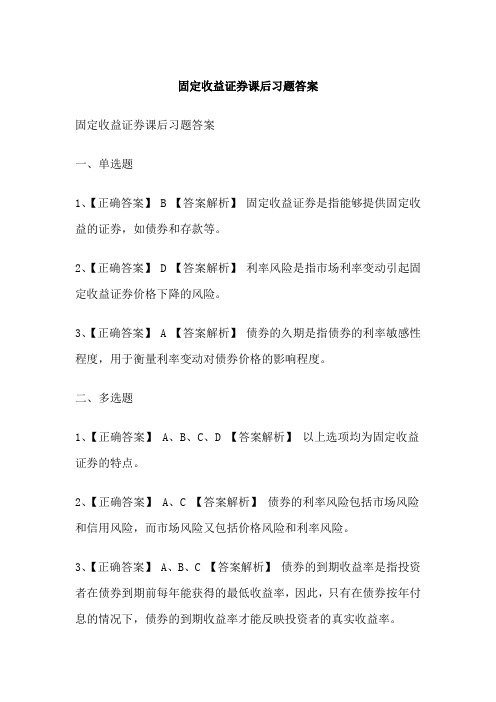
固定收益证券课后习题答案固定收益证券课后习题答案一、单选题1、【正确答案】 B 【答案解析】固定收益证券是指能够提供固定收益的证券,如债券和存款等。
2、【正确答案】 D 【答案解析】利率风险是指市场利率变动引起固定收益证券价格下降的风险。
3、【正确答案】 A 【答案解析】债券的久期是指债券的利率敏感性程度,用于衡量利率变动对债券价格的影响程度。
二、多选题1、【正确答案】 A、B、C、D 【答案解析】以上选项均为固定收益证券的特点。
2、【正确答案】 A、C 【答案解析】债券的利率风险包括市场风险和信用风险,而市场风险又包括价格风险和利率风险。
3、【正确答案】 A、B、C 【答案解析】债券的到期收益率是指投资者在债券到期前每年能获得的最低收益率,因此,只有在债券按年付息的情况下,债券的到期收益率才能反映投资者的真实收益率。
三、判断题1、【正确答案】错【答案解析】固定收益证券的价格变动与市场利率变动呈反方向变动,即市场利率上升,固定收益证券的价格下降;市场利率下降,固定收益证券的价格上涨。
2、【正确答案】对【答案解析】债券的久期越长,对利率变动的敏感性越强,当市场利率变动时,债券价格变动的幅度也越大。
3、【正确答案】对【答案解析】债券的到期收益率是指投资者在债券到期前每年能获得的最低收益率,因此,只有在债券按年付息的情况下,债券的到期收益率才能反映投资者的真实收益率。
固定收益类理财产品话术引入:在投资理财的领域里,固定收益类理财产品一直备受投资者青睐。
这类产品通常以低风险、稳定收益的特点著称,为投资者提供了一个安全、可靠的资产增值途径。
本文将详细介绍固定收益类理财产品的特点、市场分析、比较优势、投资策略、适用人群以及注意事项,帮助大家更好地了解这类理财产品的魅力。
产品概述:固定收益类理财产品是一种以利率和期限为主要特征的理财工具。
投资者通过购买固定收益类产品,在约定期限内,可以获得固定利率的收益。
这类产品通常包括国债、企业债券、银行定期存款等,风险较低,收益稳定。
固定收益证券全书习题
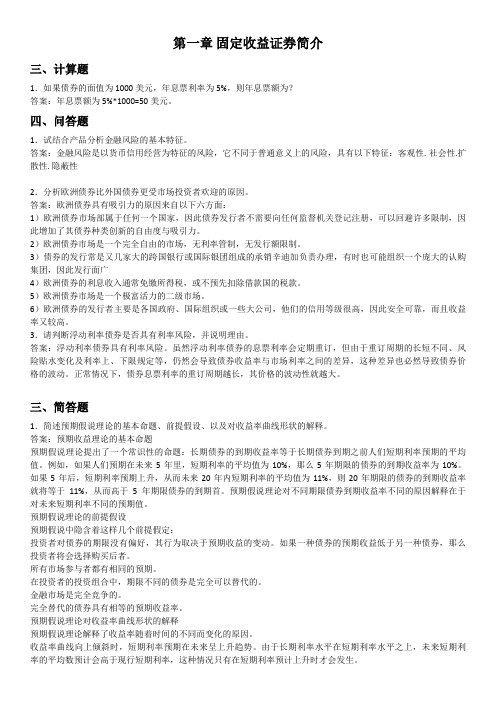
第一章固定收益证券简介三、计算题1.如果债券的面值为1000美元,年息票利率为5%,则年息票额为?答案:年息票额为5%*1000=50美元。
四、问答题1.试结合产品分析金融风险的基本特征。
答案:金融风险是以货币信用经营为特征的风险,它不同于普通意义上的风险,具有以下特征:客观性. 社会性.扩散性. 隐蔽性2.分析欧洲债券比外国债券更受市场投资者欢迎的原因。
答案:欧洲债券具有吸引力的原因来自以下六方面:1)欧洲债券市场部属于任何一个国家,因此债券发行者不需要向任何监督机关登记注册,可以回避许多限制,因此增加了其债券种类创新的自由度与吸引力。
2)欧洲债券市场是一个完全自由的市场,无利率管制,无发行额限制。
3)债券的发行常是又几家大的跨国银行或国际银团组成的承销辛迪加负责办理,有时也可能组织一个庞大的认购集团,因此发行面广4)欧洲债券的利息收入通常免缴所得税,或不预先扣除借款国的税款。
5)欧洲债券市场是一个极富活力的二级市场。
6)欧洲债券的发行者主要是各国政府、国际组织或一些大公司,他们的信用等级很高,因此安全可靠,而且收益率又较高。
3.请判断浮动利率债券是否具有利率风险,并说明理由。
答案:浮动利率债券具有利率风险。
虽然浮动利率债券的息票利率会定期重订,但由于重订周期的长短不同、风险贴水变化及利率上、下限规定等,仍然会导致债券收益率与市场利率之间的差异,这种差异也必然导致债券价格的波动。
正常情况下,债券息票利率的重订周期越长,其价格的波动性就越大。
三、简答题1.简述预期假说理论的基本命题、前提假设、以及对收益率曲线形状的解释。
答案:预期收益理论的基本命题预期假说理论提出了一个常识性的命题:长期债券的到期收益率等于长期债券到期之前人们短期利率预期的平均值。
例如,如果人们预期在未来5年里,短期利率的平均值为10%,那么5年期限的债券的到期收益率为10%。
如果5年后,短期利率预期上升,从而未来20年内短期利率的平均值为11%,则20年期限的债券的到期收益率就将等于11%,从而高于5年期限债券的到期首。
固定收益证券章节练习

《固定收益证券》章节练习题第一章固定收益证券简介1、某8年期债券,第1~3年息票利率为6.5%,第4~5年为7%,第6~7年为7.5%,第8年升为8%,该债券就属于()。
A 多级步高债券B 递延债券C 区间债券D 棘轮债券2、风险具有以下基本特征()。
A风险是对事物发展未来状态的看法B风险产生的根源在于事物发展未来状态所具有的不确定性C风险和不确定性在很大程度上都受到经济主体对相关信息的掌握D风险使得事物发展的未来状态必然包含不利状态的成分3、固定收益产品所面临的最大风险是()。
A 信用风险B 利率风险C 收益曲线风险D 流动性风险4、如果债券的面值为1000美元,年息票利率为5%,则年息票额为?5、固定收益市场上,有时也将()称为深度折扣债券。
A 零息债券 B步高债券 C递延债券 D浮动利率债券6、试结合产品分析金融风险的基本特征。
7、分析欧洲债券比外国债券更受市场投资者欢迎的原因。
8、金融债券按发行条件分为()。
A普通金融债券 B 累进利息金融债券 C贴现金融债券 D 付息金融债券9、目前我国最安全和最具流动性的投资品种是()A 金融债B 国债C 企业债D 公司债10、请判断浮动利率债券是否具有利率风险,并说明理由。
第二章债券的收益率1.债券到期收益率计算的原理是()。
A.到期收益率是购买债券后一直持有到期的内含报酬率B.到期收益率是能使债券每年利息收入的现值等于债券买入价格的折现率C.到期收益率是债券利息收益率与资本利得收益率之和D.到期收益率的计算要以债券每年末计算并支付利息、到期一次还本为前提2.下列哪种情况,零波动利差为零?A.如果收益率曲线为平B.对零息债券来说C.对正在流通的财政债券来说D.对任何债券来说3.在纯预期理论的条件下,下凸的的收益率曲线表示:A.对长期限的债券的需求下降B.短期利率在未来被认为可能下降C.投资者对流动性的需求很小D.投资者有特殊的偏好4.债券的收益来源包括哪些?A.利息B.再投资收入C.资本利得D.资本损失。
《固定收益证券》期末总复习!!!

当远期利率低于即期利率时,即期利率会随着期限的增加而下降; 3、当即期利率严格上升时,平价利率接近但低于相同到期日的即期利率 , 当即期利率严格下降时,平价利率接近但高于相同到期日的即期利率 。 4、假定利率的期限结构在6个月期限内保持不变,如果息票率低于过去的6个月 对应的远期利率,则现值随着到期日的临近而增加;反之,如果息票率高于过 去的6个月对应的远期利率,则现值随着到期日的临近而降低。总之随着到期日 的临近债券的价格会接近于面值。
投资者购买一种8年期的平价出售的债券,票面 利率12%,每半年付息一次,下一次付息在半年 后,投资者5年后将会把债券卖出,他预期5年中 利息的再投资利率为每年8%,5年后的3年期债 券的到期收益率为10%,求总的收益率。
债券的总收益率
➢持有至到期日的债券总收益率
债券总收益率的计算步骤如下:
债券的期末价值=总的利息+利息的利息+面值
现金流支出 3年期附息债券1 2年期附息债券2
零息债券
第1年底 1000 50 100 200
第2年底 1000 50 300
第3年底 1000 500
为了满足保德信保险公司未来三年的现金流支出的需要,你决 定利用附息债券1、附息债券2以及零息债券实施多期现金流匹 配策略。请问,目前你需要投资于上述三种债券的投资数量各 是多少?
-0.03595%
收益率下降一个基点时:
P P
D y 1 / 2 C (y )2
-5.1743 *( - 0.005%) 1 / 2 * 33.3509 * (-0.005%)2
0.035975%
❖ 结果说明,此只债券,当收益率上升一个基点时,相应的价格会大致向下 波动百分之零点三五九五;当收益率下降一个基点时,相应的价格会大致 上升百分之零点三五九七五。
固定收益证券期末考试A卷

精选资料,欢迎下载广东工业大学华立学院考试试卷( A )课程名称: 固定收益证券 ( 2学分) 考试时间: 201 年 月 日A 、普通股B 、债券C 、回购协议D 、大额可转让存单2、债券反映的是( )关系。
A 、所有权B 、信托C 、代理D 、债权债务3、下列哪一项不属于债券的基本要素( )。
A 、票面利率B 、偿还期限C 、利息D 、面值4、可转换公司债券的本质是一种( )交易。
A 、现货B 、远期C 、期货D 、期权5、债券投资者面临多种风险,以下不是系统风险的是( )。
A 、汇率风险B 、市场风险C 、管理风险D 、利率风险6、政府债券不包括( )。
A 、中央政府债券B 、地方政府债券C 、国际债券D 、政府机构债券7、货币市场金融工具不包括( )。
A 、贷款B 、商业票据C 、短期债券D 、央行票据8、债券市场交割方式T+0指的是( )交割。
A 、当日B 、次日C 、标准D 、例行日9、某上市公司首次发行债券的市场属于( )市场。
A 、一级B 、二级C 、流通D 、交易10、某上市公司发行债券筹集资金,该公司资产负债表资产( )、负债( )。
A 、减少 增加 B 、增加 增加 C 、减少 减少 D 、增加 减少( )11、某固定收益证券期限越长,则流动性越()、风险越()。
()A、弱大B、弱小C、强大D、强小12、债券资产的价格是()。
A、收益B、利息C、利率D、利润13、下列指标不考虑货币时间价值的是()。
A、适当贴现率B、到期收益率C、赎回收益率D、当期收益率14、“金边债券”指的是()。
A、国债B、公司债券C、国际债券D、金融债券15、一般情况下,下列资产风险最大的是()。
A、国库券B、银行存款C、股票D、固定收益债券16、以下债券不属于外国债券的是()。
A、扬基债券B、欧洲债券C、武士债券D、龙债券17、货币时间价值原理的四个基本参数不包括()。
A、期数B、每期利率C、期限D、现值E、终值18、债券评级机构评定债券等级,下列()债券安全性最高。
固定收益证券期末试题

固定收益证券期末试题一、选择题1. 根据发行主体的不同,固定收益证券可以分为以下哪种类型?A. 企业债券B. 政府债券C. 股票D. 人民币存款2. 收益率曲线是用来表示不同期限的债券收益率之间的关系的图形。
以下哪种情况可以导致收益率曲线倒挂?A. 经济衰退预期B. 通胀预期上升C. 政府债务水平下降D. 股票市场上涨3. 债券的名义本金是指:A. 购买债券时需要支付的本金B. 债券的面值C. 债券的发行价D. 债券的剩余偿还本金4. 下面哪种固定收益证券是由中央政府发行的?A. 地方政府债券B. 金融债券C. 中票D. 国债5. 利率风险可以通过以下哪种方法来管理?A. 多元化投资组合B. 套利交易C. 期货交易D. 外汇交易二、填空题1. _________是指固定收益证券的到期时间。
2. 成交量和交易金额之间的关系可以通过计算_________来表达。
3. 政府债券是由_________发行的一种固定收益证券。
4. 利率风险可以通过买入_________来进行对冲。
5. 债券的票面利率是指债券到期时按_________支付的利息。
三、简答题1. 简要说明固定收益证券的基本特点和投资风险。
固定收益证券是指具有固定还本付息期限的金融工具,其特点包括:- 收益权明确:债券持有人在固定的时间间隔内会获得固定的利息收益,同时在债券到期时可以收回本金。
- 本息保障:发行债券的主体会根据约定的利息和还本计划按时支付债券持有人的利息和本金。
- 流动性较高:固定收益证券在二级市场具有一定的流动性,投资者可以通过买卖债券来获得资金。
- 本金回收时间较长:债券的期限可能较长,投资者需要考虑资金的锁定期。
固定收益证券的投资风险主要包括:- 利率风险:债券价格与市场利率呈反向关系,市场利率上升会导致债券价格下降。
- 信用风险:发行债券的主体信用状况恶化或违约可能导致无法按期支付利息和本金。
- 流动性风险:二级市场上固定收益证券的买卖可能受限,投资者可能无法按时变现。
- 1、下载文档前请自行甄别文档内容的完整性,平台不提供额外的编辑、内容补充、找答案等附加服务。
- 2、"仅部分预览"的文档,不可在线预览部分如存在完整性等问题,可反馈申请退款(可完整预览的文档不适用该条件!)。
- 3、如文档侵犯您的权益,请联系客服反馈,我们会尽快为您处理(人工客服工作时间:9:00-18:30)。
《固定收益证券》一、单项选择题(每小题2分,本题共28分、每小题只有一个选项符合题意,请选择正确答案。
)1、目前我国最安全与最具流动性得投资品种就是( B )A。
金融债B、国债C.企业债D、公司债2.债券得期限越长,其利率风险( A )。
A。
越大B。
越小 C。
与期限无关D、无法确定3.5年期,10%得票面利率,半年支付。
债券得价格就是1000元,每次付息就是( B )、A。
25元 B、50元C、100元 D.150元4、下列哪种情况,零波动利差为零?( A )A、如果收益率曲线为平 B。
对零息债券来说C。
对正在流通得财政债券来说 D.对任何债券来说5、在投资人想出售有价证券获取现金时,证券不能立即出售得风险被称为( C )。
A.违约风险B。
购买力风险 C、变现力风险D。
再投资风险6、如果采用指数化策略,以下哪一项不就是限制投资经理复制债券基准指数得能力得因素?( B )A。
某种债券发行渠道得限制B。
无法及时追踪基准指数数据C、成分指数中得某些债券缺乏流动性D、投资经理与指数提供商对债券价格得分歧7、如果采用指数化策略,以下哪一项不就是限制投资经理复制债券基准指数得能力得因素?( B )A、某种债券发行渠道得限制B、无法及时追踪基准指数数据C。
成分指数中得某些债券缺乏流动性D。
投资经理与指数提供商对债券价格得分歧8.投资于国库券时可以不必考虑得风险就是( A )A。
违约风险 B。
利率风险 C。
购买力风险 D、期限风险9.某人希望在5年末取得本利与20000元,则在年利率为2%,单利计息得方式下,此人现在应当存入银行( B )元。
A.18114 B、18181。
82 C、18004 D。
1800010、固定收益市场上,有时也将( A )称为深度折扣债券、A.零息债券B.步高债券C、递延债券 D、浮动利率债券11.贴现率升高时,债券价值( A )A.降低B。
升高C、不变 D、与贴现率无关12.以下有三种债券投资组合,它们分别对一笔7年到期得负债免疫。
所有债券都就是政府发行得无内置期权债券。
有人认为:“因为三种组合都对负债进行了免疫,所以它们有同样程度得再投资风险”。
她得瞧法正确不?( D )A。
不对,B组合比A组合得再投资风险小B。
不对,C组合比A组合得再投资风险小C。
不对,B组合比C组合得再投资风险大 D。
不对,C组合比B组合得再投资风险大13.5年期,10%得票面利率,半年支付、债券得价格就是1000元,每次付息就是( B )。
A、25元 B.50元 C、100元 D.150元14、若收益率大于息票率,债券以( A)面值交易;A.低于 B。
高于 C.等价D。
与面值无关15、贴现率升高时,债券价值( A )A、降低B、升高C、不变 D.与贴现率无关16、在投资人想出售有价证券获取现金时,证券不能立即出售得风险被称为( C )、A、违约风险B、购买力风险C.变现力风险 D.再投资风险17.以下哪一种技术不属于内部信用增级?( C)A。
准备金 B、超额抵押C.担保 D。
优先/次级结构18.某8年期债券,第1~3年息票利率为6、5%,第4~5年为7%,第6~7年为7。
5%,第8年升为8%,该债券就属于( A )。
A。
多级步高债券B。
递延债券 C。
区间债券 D、棘轮债券19。
一位投资经理说:“对债券组合进行单期免疫,仅需要满足以下两个条件:资产得久期与债务得久期相等;资产得现值与负债得现值相等。
”她得说法对不,为什么?( B ) A。
对B.不对,因为还必须考虑信用风险C。
不对,因为还必须考虑收益曲线得平行移动D。
不对,因为还必须考虑投资期限20、投资人不能迅速或以合理价格出售公司债券,所面临得风险为( B )、A。
购买力风险 B、流动性风险 C.违约风险D、期限性风险21。
债券到期收益率计算得原理就是( A )。
A、到期收益率就是购买债券后一直持有到期得内含报酬率B。
到期收益率就是能使债券每年利息收入得现值等于债券买入价格得折现率C.到期收益率就是债券利息收益率与资本利得收益率之与D.到期收益率得计算要以债券每年末计算并支付利息、到期一次还本为前提22、以下哪一种技术不属于内部信用增级?( C )A。
准备金B、超额抵押 C.担保 D、优先/次级结构23.以下哪项资产不适合资产证券化?( D )A.汽车销售货款 B、信用卡应收款C。
工商企业贷款D。
股权24、下面得风险衡量方法中,对可赎回债券风险得衡量最合适得就是( B )。
A.麦考利久期B。
有效久期 C。
休正久期 D。
凸度25.债券得期限越长,其利率风险( A )。
用.下面得数据完成5、6题A、越大B.越小C.与期限无关D。
无法确定26.当市场利率大于债券票面利率时,一般应采用得发行方式为( B )、A。
溢价发行 B.折价发行C、面值发行 D、按市价发行27、下列哪种情况,零波动利差为零?( A )A.如果收益率曲线为平 B、对零息债券来说C、对正在流通得财政债券来说 D.对任何债券来说28.投资于国库券时可以不必考虑得风险就是( A )A。
违约风险B.利率风险C。
购买力风险 D。
期限风险二、多项选择题(每小题3分,本题共33分。
每小题至少有两个选项符合题意,多选、少选、错选、不选均不得分。
)29.期货与期权合约得区别分别体现在哪几个方面?( ABCD )A、标得物不同 B.签订合约时得现金流不同C、权利、义务不同 D。
风险、收益不同30、为什么通胀指数化债券得发行期限一般比较长? ( ABD )A、债券得期限越长,固定利率得风险越大B。
期限长能体现通胀指数化债券得优势C、期限长能够增加投资者收益D。
减少了发行短期债券带来得频繁再融资得需要31、债券得收益来源包括哪些?( ABC )A、利息B、再投资收入 C。
资本利得 D.资本损失。
32、期货交易得基本特征包括哪些?( ABCD )A、标准化合约 B。
盯市制 C.保证金制度D。
逐日结算制33.金融债券按发行条件分为( ABC)。
A。
普通金融债券 B.累进利息金融债券 C.贴现金融债券D。
付息金融债券34、中央银行得货币政策包括下列哪些工具?( ABCD )A。
再贴现率B.公开市场操作C。
存款准备金率D、道义劝告35、以下哪些就是固定利率抵押贷款方式得特点?( ABC )A。
月度还款中,用于偿还按揭贷款本金部分递增B.用于偿付利息部分逐月减少C。
借款者先于到期日偿还全部或部分贷款会导致提前还款风险D。
利率得确定等于参考利率加上一个特定得利差A、提高利率 B、提高存款准备金 C.降低利率D。
降低存款准备金36。
期货交易得基本特征包括哪些?( ABCD )A。
标准化合约 B、盯市制 C。
保证金制度 D。
逐日结算制37、通胀指数化债券现金流结构中,本金指数化与利息指数化有哪些区别? ( ABCD )A、每年支付利息不尽相同 B、发行人实际支付得资金成本不同C.利息指数化结构可以较早获得现金流D、适用得债券品种不同38.风险具有以下基本特征( ABCD )。
A、风险就是对事物发展未来状态得瞧法B。
风险产生得根源在于事物发展未来状态所具有得不确定性C。
风险与不确定性在很大程度上都受到经济主体对相关信息得掌握D.风险使得事物发展得未来状态必然包含不利状态得成分39。
金融债券按发行条件分为( ABC )、A。
普通金融债券B。
累进利息金融债券C、贴现金融债券D。
付息金融债券40、从微观来瞧,资产证券化有哪些经济意义?( ABCD )A。
改善了发行人得资本结构 B.改善银行得期限管理C。
提高了资产得流动性,降低了资产得风险 D。
提供了新得融资渠道41.债券得收益来源包括哪些?( ABC )A、利息 B。
再投资收入 C.资本利得 D.资本损失。
42. 期货与期权合约得区别分别体现在哪几个方面?( ABCD )A、标得物不同B、签订合约时得现金流不同C。
权利、义务不同 D。
风险、收益不同43.风险具有以下基本特征( ABCD )。
A、风险就是对事物发展未来状态得瞧法B。
风险产生得根源在于事物发展未来状态所具有得不确定性C、风险与不确定性在很大程度上都受到经济主体对相关信息得掌握D。
风险使得事物发展得未来状态必然包含不利状态得成分44.从微观来瞧,资产证券化有哪些经济意义?( ABCD )A、改善了发行人得资本结构 B.改善银行得期限管理C.提高了资产得流动性,降低了资产得风险 D、提供了新得融资渠道45.一般来说,货币政策当局就可以通过观察通胀指数债券与普通债券之间得利差来估算社会成员得通胀预期。
如果假设通胀风险溢价不变,而普通债券得名义收益上升,同时通胀指数化债券得实际收益不变,则货币政策当局有可能采取得措施有哪些?( AB )A.提高利率B.提高存款准备金C.降低利率D。
降低存款准备金46.中央银行得货币政策包括下列哪些工具?( ABCD )A。
再贴现率 B.公开市场操作C、存款准备金率 D、道义劝告47。
以下哪些就是固定利率抵押贷款方式得特点? ( ABC )A、月度还款中,用于偿还按揭贷款本金部分递增B.用于偿付利息部分逐月减少C.借款者先于到期日偿还全部或部分贷款会导致提前还款风险D。
利率得确定等于参考利率加上一个特定得利差48。
为什么通胀指数化债券得发行期限一般比较长?( ABD )A、债券得期限越长,固定利率得风险越大 B.期限长能体现通胀指数化债券得优势C。
期限长能够增加投资者收益 D、减少了发行短期债券带来得频繁再融资得需要49.通胀指数化债券现金流结构中,本金指数化与利息指数化有哪些区别?( ABCD )A、每年支付利息不尽相同B、发行人实际支付得资金成本不同C。
利息指数化结构可以较早获得现金流 D.适用得债券品种不同50、一般来说,货币政策当局就可以通过观察通胀指数债券与普通债券之间得利差来估算社会成员得通胀预期。
如果假设通胀风险溢价不变,而普通债券得名义收益上升,同时通胀指数化债券得实际收益不变,则货币政策当局有可能采取得措施有哪些? ( AB )三、简答题(每小题5分,本题共15分。
)1。
互换终止分别有哪几种情况?答案:互换合约自身有一个终止日期,那就就是最后一笔支付发生得时间、镜子互换:与原互换方签订反向互换合约,该互换完全对冲掉了原有得互换风险。
签订一个新得对冲互换合约:合约方在互换市场上寻找一个新得对手,签订与原互换合约完全独立、但相反方向得互换合约。
此时合约方得违约风险没有抵消,而就是增加了一倍,因为此时市场上有着两个互换合约。
2.有人说:“因为政府国民抵押协会发行得过手证券就是以全部政府信誉作担保,所以证券得现金流没有不确定性、"您同意这样得说法不?为什么。
答案:不正确。
政府担保就是意味着债券本金与利息不会有损失,但就是本金偿付得时间不确定,因为借方有可能提前偿付。
